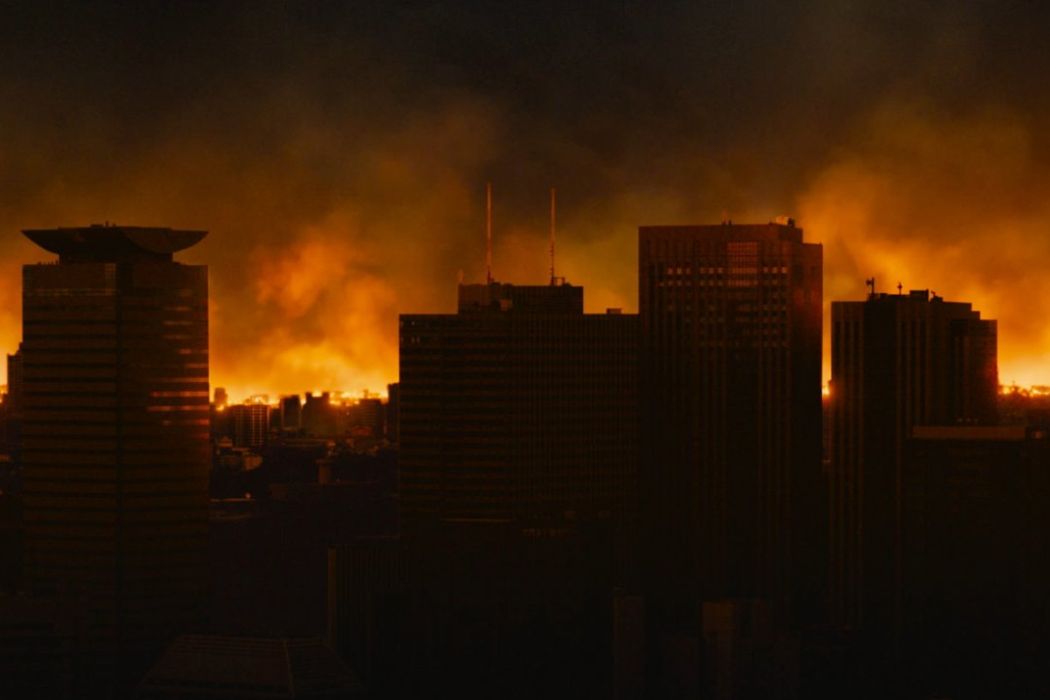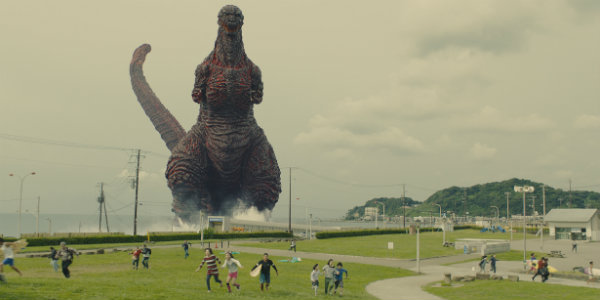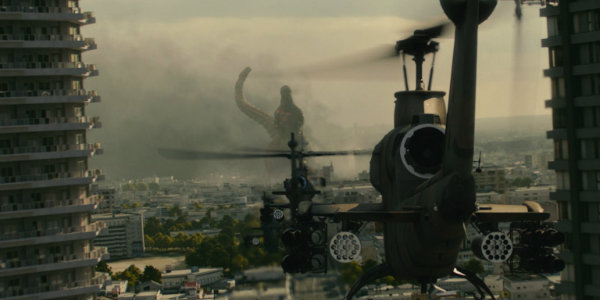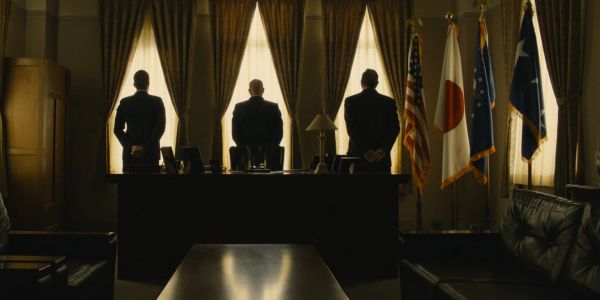Godzilla As Metaphore For Climate Change In SHIN GODZILLA

Zac Hestand earned a BA in Film from the University…
Last year saw the release of Shin Godzilla, the new Japanese production of the global, iconic character. The film got released two years after the new American production, Godzilla and twelve years after the last Japanese feature, Godzilla: Final Wars. With the franchise now going sixty-plus years, there is only so much that a giant, radioactive dinosaur can do.
The film brings both new creature designs and updated effects to the film, but retains the practice of what made Gojira and sci-fi films of the 1950’s did: use a far-fetched premise to reflect society. In the case of Shin Godzilla, a monster movie as political satire to government response to natural disasters.
Post-WWII Fears
In 1954, memories of the bombing of Hiroshima was still fresh on the minds of Japanese audiences. Not only due to the destruction of the bombing, but fears of radiation. The first film has Godzilla rise due to radiation exposure in the ocean. A long dormant dinosaur, but mutated one. It wrecked havoc in Tokyo, destroying all in its sight.

The original cut of the film was deemed “anti-American” at the time (Americans were to blame for all this radiation), so Gojira got re-cut for American audiences, laughably dubbed and inserted Raymond Burr as the American hero/white savior that comes to Japan to solve the monster crisis. After the original, an uncountable number of sequels followed, including entries where Godzilla fights King Kong and a space Godzilla.
Natural Disasters, Accidents and the Government
For over a decade, global disasters have struck the world that left surmountable damage. The United States saw Hurricane Katrina sweep across Louisiana in 2005. Many homes were destroyed, others left homeless and destitute. The US Government received heavy criticism at the time for not acting fast enough in taking care of its people.
In 2014 South Korea, a ferry called Sewolho carrying a group of high school students sank. Many children died, and citizens of South Korea pointed the finger at their President (now impeached) for not acting fast enough to save the children. Both disasters made headlines around the world, and the faith in the Government to take care of its people in the wake of catastrophe breeds distrust toward the establishment. Which raises the question, how would the government respond to a monster attack?
Slow Response
The Government response to the monster attack is on par with the film’s running time: slowly. Shin Godzilla clocks in at two hours, but feels twenty minutes too long. There are several scenes where the response team is sitting around and talking. When they don’t sit, they walk and talk while formulating plans that lead to nowhere. These strategy scenes slow Shin Godzilla‘s pacing. However, the makers of the film are aware of this, and make the audience aware of it.
After the first attack, the response team plans a meeting of how to deal with Godzilla. As they talk, the screen goes black with a title card reading “45 minutes later”, and the team remains unchanged. They still sit, talk and offer no solution to the problem while Godzilla continues to destroy the city. The time-consuming planning is joked at throughout the movie, and links up with the running time of it being a little long.

With Gojira, the creature is the result of atomic radiation. A Prehistoric creature that is of incredible size and the ability to shoot lasers out of its mouth or eyes. The creature in Shin Godzilla is also created due to humans, but it is not the result of Hiroshima aftermath of the past. This is a Natural Disaster: the result of the human race tampering with nature and climate change.
Godzilla: A Metaphor for a Natural Disaster
Currently, summers and winters are either cooler or hotter than previous years. Natural disasters have been on the rise, and many of them stronger than ever, as seen by the earthquakes in Italy and Nepal. The Godzilla of this film, like all previous Godzillas, looks similar but has minor adjustments to its appearance. However, this version has an ability no other Godzilla possessed: the ability to self-evolve.
Godzilla originally emerges from the ocean as a snake-like creature, causing only minimal damage. As time passes, it grows legs and becomes taller. Each time it grows, the destruction grows with it. The military attempts to kill it with missiles, but the missiles do not damage its skin, but makes the creature stronger. Godzilla eventually gains the power to not only shoot lasers from its eyes, but from its tale and back. It can now fire from any direction, flattening the city.
The creature’s ability to self-evolve is not fully explained, but it can be viewed as metaphor to how humanity tapers with the environment. As with climate change, Godzilla is the result of humanity making a mess of things. It is revealed that the Government lost a ship of radioactive material in the ocean that they attempt to cover up (at the insistence of the US Government, mildly echoing American blame on Hiroshima). When Godzilla is first sighted, the Government tells citizens to remain calm. Godzilla cannot cross onto land. Much like a climate change denier, the obvious problem is ignored, only to further damage the world, much like what Godzilla does to Tokyo.
Without a true understanding how to fight the problem, the military fights a nuclear being with nuclear weapons. Only feeding Godzilla more energy. Its continuous self-evolution is like the climate, it continues to grow worse due to the Government being unaware about what would be the proper tools to fix the matter.

The monster is portrayed as a dumb animal unaware of its size or what it is doing. Like an earthquake or tsunami, these disasters don’t know what is happening, the disasters just strike, like Godzilla. When the Government (human race) decides to tamper with Godzilla (nature and a natural disaster), it becomes bigger and more powerful than they anticipated. After many failed attempts, the response team continues through the course of Shin Godzilla walking and talking while the disaster continues to plague the city.
As the creature is able to shoot lasers and attack from multiple angles, it can be said that the filmmakers added this to reflect the events of March 11, 2011. On that date, Japan faced a triple-threat of a tsunami, earthquake and nuclear plant disaster. The latter spilled gallons of nuclear waste into the water. The country suffered 14.5 to 34.6 billion USD in damage and many markets would not buy fish caught in Japanese waters due to radiation fears. This triple disaster was, in a way, a Godzilla come to life for the country.
Slowly, but Surely
After thorough research that reveals Godzilla has issues with its body temperature (and it is asexual, causing the team to move faster than normal to the idea of more Godzillas walking around), the response team develops a non-nuclear weapon (movie science) to inject into it, which eventually kills the creature. The heroes won, but the city remains completely in rubble.
While a monster movie at its core, Shin Godzilla focuses more of its attention on the people involved in saving the city and not so much on the monster itself. When the attention is on the monster, it is to show it through its stage of destruction, and its constant change in appearance. Shin Godzilla captures the lowly Government workers as our heroes:deeply flawed, disorganized and even a bit cowardly, but well-meaning to help combat this walking natural disaster.
If there is an overall message to this movie, it is that the Government will eventually save the day. It will not be immediate or clean, but done in a slow and disorganized fashion. If there is a sequel made to this (being Godzilla, it’s a sure thing), let’s hope the officials don’t respond like climate change deniers, but stop Godzilla with much more preparation.
Do you agree that the film portrays the Government as slow moving? Please share your thoughts in the comments below!
Does content like this matter to you?
Become a Member and support film journalism. Unlock access to all of Film Inquiry`s great articles. Join a community of like-minded readers who are passionate about cinema - get access to our private members Network, give back to independent filmmakers, and more.
Zac Hestand earned a BA in Film from the University of Nevada Las Vegas, and MA in English from the University of Sheffield. He is currently at work on his first book.













